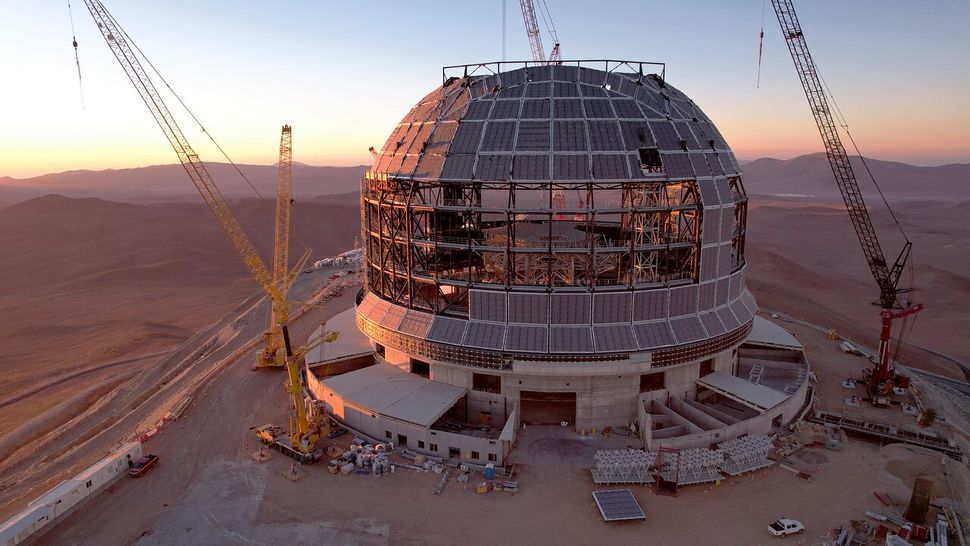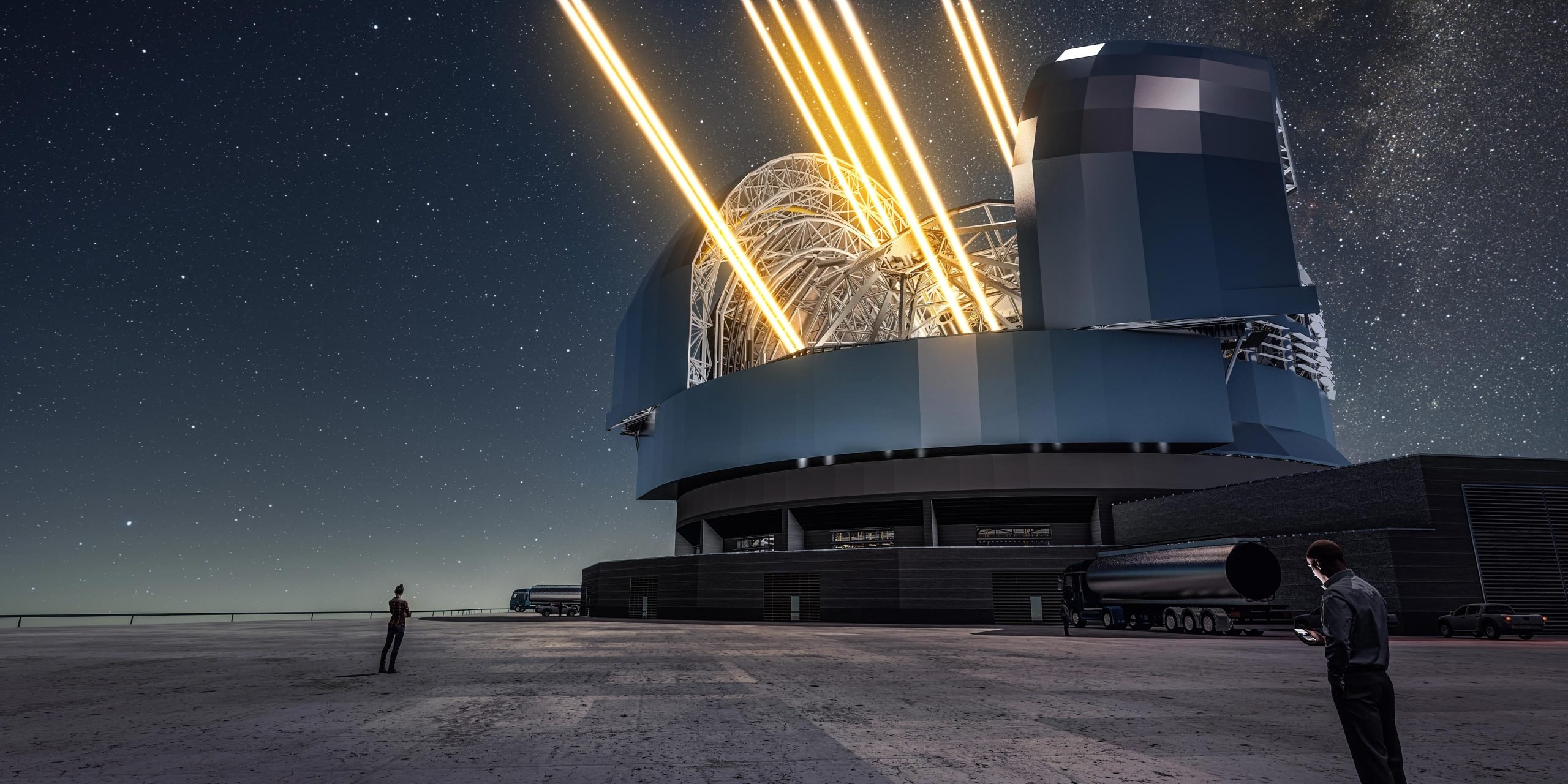Latin America
Related: About this forumWorld's largest telescope continues taking shape on Chilean mountain (photos)
By Samantha Mathewson published 14 hours ago
"Notice the cranes and vehicles at the bottom, which show off just how enormous the ELT is!"

A giant domed building under construction on the top of a desert mountain.
Protective cladding being installed on the sides of the Extremely Large Telescope (ELT) dome. (Image credit: ESO)
The dome enclosing the world's largest telescope is taking shape, with the installation of protective siding and supports for the primary mirror.
The European Southern Observatory's (ESO) Extremely Large Telescope (ELT) is currently under construction on the Cerro Armazones mountain in Chile's Atacama Desert and is expected to see its first light by 2028.
Recent progress photos from the construction site taken in June 2024 show cladding being installed on the outside of the ELT dome. This layer of material serves as a thermal insulation barrier and provides weather resistance to help protect the telescope from the extreme environment of the Chilean desert.
Part of the dome will have large sliding doors, which will remain closed during the day and open at night, allowing the telescope to survey the sky. Once complete, the telescope will hunt for Earth-like exoplanets in search of signs of life outside of our own solar system and probe the early universe to study the first galaxies that formed after the Big Bang, among other tasks.
More:
https://www.space.com/worlds-largest-telescope-elt-construction-photos-june-2024

This is where they're headed with this project. Please click the tiny URL below for images of the work going on there on the mountain top:
https://tinyurl.com/j7pse7vf
True Dough
(20,350 posts)looks like something from Star Wars.
Judi Lynn
(162,406 posts)Thank you. ![]()
Permanut
(6,658 posts)Just idle curiosity, the location of the telescope:
- clear air in Chile, check.
- top of a 3k meter mountain for more stable air. I'm by
Latitude is relatively close to the Tropic of Capricorn. Was that relevant in selecting the location?
Judi Lynn
(162,406 posts)Haven't found it, yet, but here is a site which shows the names of the largest Chilean Atacama Desert installations, as a starting place. I will continue to look. I'm very interested in finding out about this, myself, now you've mentioned it. Northern Chile, Tropic of Capricorn, I need to get a clearer look!
I'll continue to look for more on this:
Observatories in Chile
Observatorios Astronómicos Chile
Observatorios Astronómicos Chile credit: ESO/H. Heyer
The skies of northern Chile are considered the best in the world for astronomy. A growing number of Chileans and foreigners are visiting the various facilities to observe the skies over the last decade. However, most of the observatories positioned in the Norte Chico (Third and Fourth Region), since the 60s have been for scientific use only, leaving very little for the tourist. In the mid-90's, a study by European scientists from the European Southern Observatory (ESO) decided to build a new and more sophisticated observatory, this time in the Norte Grande (Second Region), for highly scientific purposes, which will determine and reveal many mysteries in space. The place chosen was Cerro Paranal Observatory, considered the largest in the world.
More:
https://www.astronomictourism.com/astronomical-observatories-chile.html
~ ~ ~
Stumbling Towards First Light
Why has Chile, a country riven by inequality and political conflict, become a global sanctuary for the long science that drives astronomical discovery?
By Paul Constance
Mar 20, 02024
. . .
Few countries have been more successful at attracting this kind of capital than Chile. The GMT is one of three colossal observatories currently under construction in the Atacama Desert. The $1.6 billion Extremely Large Telescope, which will house a 128-foot main mirror inside a dome nearly as tall as the Statue of Liberty, will be able to directly image and study the atmospheres of potentially habitable exoplanets. The $1.9 billion Vera T. Rubin Telescope will use a 3.500 megapixel digital camera to map the entire night sky every three days, creating the first 3-D virtual map of the visible cosmos while recording changes in stars and events like supernovas. Two other comparatively smaller projects, the Fred Young Sub-millimeter Telescope and the Cherenkov Telescope Array, are also in the works.
Chile is already home to the $1.4 billion Atacama Large Millimeter Array (ALMA), a complex of 66 huge dish antennas some 16,000 feet above sea level that used to be described as the world’s largest and most expensive land-based astronomical project. And over the last half-century, enormous observatories at Cerro Tololo, Cerro Pachon, Cerro Paranal, and Cerro La Silla have deployed hundreds of the world’s most sophisticated telescopes and instruments to obtain foundational evidence in every branch of astronomy and astrophysics.
By the early 02030s, a staggering 70 percent of the world’s entire land-based astronomical data gathering capacity is expected to be concentrated in an swath of Chilean desert about the size of Oregon.

A map of major telescopes and astronomical sites in Northern Chile. Map by Jacob Sujin Kuppermann
More:
https://longnow.org/ideas/stumbling-towards-first-light/
It's imperative for anyone interested in this fascinating subject, take the time to look in Google images for each name of a telescope project mentioned, as each one is beyond description! All "Ones of a kind!"
On edit:
Forgot to thank you, Permanut, for your post. I tore off to look for more, and completely forgot to thank you for your comment!
Permanut
(6,658 posts)I'm guessing these are all optical telescopes, but I have no evidence yet to support that guess.
One comment about the Vera T Rubin telescope is also intriguing, about mapping the entire sky.
I'm not an astronomer, but I wouldn't think the entire sky would ever be visible from that far south
Permanut
(6,658 posts)Is not listing latitude as one of the chief reasons why observatories have been built there. They explain that just being at 3,000 to 5,000 meters, and having exceptionally clean air are the biggest attractions.
So - it seems that the Tropic of Capricorn is not a deciding factor.
On a different subject, one of our delightful DU posters asked a while back who we'd like to have lunch with. My response was Neal de Grasse Tyson, and I added that Judi Lynn should be invited as well.
Judi Lynn
(162,406 posts)STARGAZER'S CORNER: ADVENTURES UNDER THE NIGHT SKY
WHERE IS THE TROPIC OF CAPRICORN?
BY: ROBERT KIECKHEFER AUGUST 20, 2019

A well-traveled geophysicist recounts his curious findings at a prominent geographic benchmark in the Southern Hemisphere.
Tropic of Capricorn in Chile 2019Member's of Sky & Telescope's 2019 total solar eclipse tour pose with the Tropic of Capricorn marker in Chile's Atacama Desert. The author is at far right.
Sean Walker / Sky & Telescope
Most globes of Earth show four dashed lines that, aside from the equator, denote special latitudes related to the seasons. One of those, the Tropic of Capricorn, is the southernmost latitude at which the Sun shines directly overhead during the December solstice. It's currently at 23° 26? 12.3? south, a latitude that's decreasing (moving toward the equator) by 0.47 arcsecond (0.47?![]() per year.
per year.
A well-traveled geophysicist recounts his curious findings at a prominent geographic benchmark in the Southern Hemisphere.
Tropic of Capricorn in Chile 2019Member's of Sky & Telescope's 2019 total solar eclipse tour pose with the Tropic of Capricorn marker in Chile's Atacama Desert. The author is at far right.
Sean Walker / Sky & Telescope
Most globes of Earth show four dashed lines that, aside from the equator, denote special latitudes related to the seasons. One of those, the Tropic of Capricorn, is the southernmost latitude at which the Sun shines directly overhead during the December solstice. It's currently at 23° 26? 12.3? south, a latitude that's decreasing (moving toward the equator) by 0.47 arcsecond (0.47?![]() per year.
per year.
Last month, while on a Sky & Telescope tour to see this year's total solar eclipse, we stopped at a Tropic of Capricorn sign about 60 km south-southeast of San Pedro de Atacama, Chile, on Highway 23, and 50 km south-southwest of ALMA, the Atacama Large Millimeter/submillimeter Array of 66 radio telescopes high in the Andes.
The sign, shown above, reads "Lat. 23° 26? 16? [south]". It turns out that this was indeed the exact latitude of the Tropic of Capricorn in 2011. The sign is in good condition and might have been erected in 2011. So far, so good.
The GPS receiver on my phone, however, noted that the sign is actually located at about 23° 26? 49.1? south. That's about 1.13 km south of the current Tropic line. (I also measured the longitude to be 67° 59? 44.1? west.)
You might ask how accurate my GPS receiver is. Since the U.S. Air Force removed the "dither" from the GPS signal in 2000, single fixes on hand-held devices have had a 50:50 horizontal uncertainty of a few meters. (That is, about half of the fixes are within a few meters of the true location.) On a Google satellite image, the latitude and longitude of the Tropic monument on Highway 23 are within a few meters of the values measured by my GPS receiver.
More:
https://skyandtelescope.org/observing/stargazers-corner/where-is-the-tropic-of-capricorn/
Atacama Large Millimeter/submillimeter Array